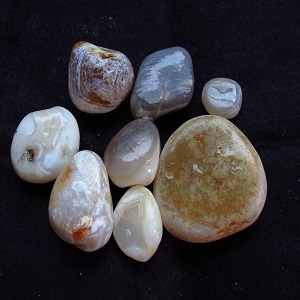The history of emerald
Emerald is the most expensive stone in the beryl group. The name of this stone is derived from the old French word esmeralde, which is derived from the Greek word smaragdos, which means green stone
Emerald is a dark green stone from the beryl group that is colored with chromium. Green beryl whose color is formed by vanadium is not necessarily emerald, but a normal green beryl
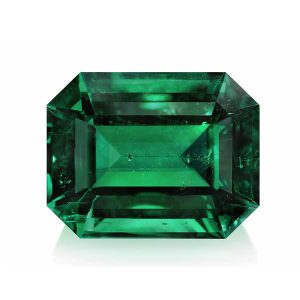
Since 1960, the American jewelry industry changed this definition and considered vanadium-colored beryls as emeralds, but this practice was not true in England and Europe
The old green color of emerald has no rival in the world of gemstones and is considered one of the top four most expensive gemstones, these four stones are ruby, Lal Badakhshan and diamond plus emerald
Although emerald is one of the most valuable gemstones in the world today, most of them break very quickly due to their low resistance
According to GIA, emerald is a type 3 transparent gemstone, meaning that even its good quality used in jewelry is in the ratio of I2 to I3
Emerald mining centers
Although Colombia is the most famous source of green emeralds, their deposits have been mined in various places around the world
In recent decades, emerald production has increased due to new discoveries in South America, Africa and Europe
Today, Brazil and Zambia are among the top producers of emeralds, followed by Colombia
Brazilian emeralds are more expensive due to their transparency and yellowish green color
While Zambian emeralds have a special blue-green color and are similar to Colombian green emeralds
Identification of natural emeralds
Almost all natural emeralds contain nasaragi, and in all of them, oil or angem is used to fill the cracks and fissures
It is the presence of these oils and gems that make it easy to distinguish natural emeralds from other similar gems
The artificial light shined and the cracks and fissures in the stone will confirm the emerald is natural
The emerald color is due to the presence of chromium and vanadium, and under natural light, the color is very prominent. One of the easiest ways to identify green emeralds is to test them for density and hardness
Like all types of beryl, emerald is harder than apatite, quartz, and feldspar, but softer than spinel, topaz, and ruby
However, emerald is more fragile than beryl and the reason is the presence of many impurities in this stone
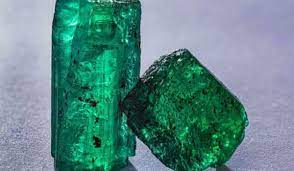
Digging for emeralds is usually done inside large rocks because emeralds form inside small veins or cave walls
Colombia is the international center of the search for emeralds
The Mozo mine in northwest Bogotá produces high-quality green stones
The Chivor mine in the northeast of Bogotá is another important source, and of course there are countless places in the country for emerald mining
Brazil has several reservoirs in Bahia, Guias and Minas Gerais
The stones of these areas are more transparent than the Colombian stones and are mostly green-yellow, and there is no slag in them
Brazil offers cat’s eye emeralds and extremely rare six-pointed star emeralds
South African reservoirs are concentrated in the Northern Transvaal
But only five percent of the stones found in Kobra and Somerset mines are of good quality
Zimbabwe has many emerald deposits, the most important of which is the Sandawana mine in the south. The crystals are small but of good quality
Russia has reservoirs in the Urals north of Sverdlovsk
There are other sources in Afghanistan, Australia, Ghana, India, Madagascar, Malawi, Mozambique, Namibia, Nigeria, Pakistan, Tanzania, Zambia and the United States of America
In the case of emeralds, even more so than other colored gemstones, it is the color that is considered the main indicator of its value
Emeralds are dark green to blue-green and sometimes green-yellow beryl
The green color of these stones is due to the presence of chromium and vanadium impurities. The most popular and valuable stone is slightly blue-green, however, the more blue it is, the less valuable it is
The term Colombian emeralds is commonly used to describe brilliant blue-green stones regardless of where they were obtained
Emeralds that are lighter in color are called Brazilian emeralds even if they are mined in Africa
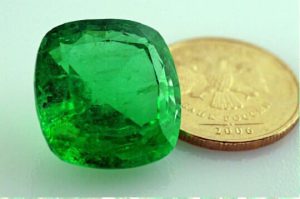
Transparency and brilliance of emerald
Emeralds have a glassy luster when cut and polished
Although their transparency ranges from brilliant to opaque, brilliant examples are more valuable
Clarity is important, but emeralds have more clarity than other gems. Unlike the other members of the beryl group, emeralds are very rare
Of course, their presence should not be considered a negative feature because they are also found in other gemstones
These impurities are part of the identity of the stone and are considered to indicate the authenticity of the emerald
If an emerald does not have any visible roughness to the naked eye, it is fine
Such stones have the highest price, especially if they are in an ideal color grade
Emerald cutting and polishing
Emeralds are usually cut in a way that is special for this category, i.e. emerald cut. An emerald cut is a rectangular or square stepped cut with beveled corners
This cutting style multiplies the beauty and color of the stone and at the same time protects the mechanical resistance and internal pressure of the stone
Emeralds are also cut in shapes like pear, oval and circle. Materials that are in lower grades are usually cut into grains and beads
Transparent and shiny materials are cut in such a way that their transparency is multiplied
Improvement of emerald stone
Oiling is one of the most common methods of preparing emeralds and is often done in the same mine
The term oiling means placing emeralds in colorless oil or resin to enhance color, clarity, and resistance
This is usually done through a hole to help the material penetrate. Non-standard methods are the use of colored oils and resins such as epoxy
By using these methods, the appearance of Lal will improve, but you must be very careful when cleaning
Brine, solution and ultrasonic cleaners can remove the oil and thus the imperfections appear
Since emeralds can be preserved by re-oiling, damage to them is temporary
Mixed emeralds became available as early as 1848
In 1950, compounding methods were introduced and excellent quality compounds were introduced in the market
The term Chatham emerald refers to emeralds that are created in a laboratory
There are many double emerald stones. In many cases their top is covered with glass or some other compound and then an emerald green liquid is poured over it

Emerald gemological features
Type: emerald-beryl
Chemical formula: Al2Be3Si6O18- aluminum beryllium silicate
Crystal structure: hexagonal, hexagonal crystal
Color: Emerald green to green to slightly blue or yellowish green
Hardness: 7.5 to 8 on the Mohs scale
Refractive index: 1.565 to 1.602
Density: 2.67 to 2.78
Cleavage: unknown
Transparency: transparent to opaque
Double refraction or two-way refraction: -0.006
Luster: glassy
Shabnak: usually not
Emerald belongs to an important group of beryl gemstones
There are different types of beryl gemstones, most of which are categorized by color and coloring elements such as pink morganite and red bixbite
There are other green colored gemstones that may be confused with green emerald, such as green clear quartz, demantoid, tsavorite, chrome tourmaline, green chrome pyroxene, grossularite, overaerite, verdlite, fluorite, hydnite, and green amethyst
Related and similar gemstones
Goshnite, Morganite, Heliador, Bixbit and Trapich Emerald
What are the world famous emeralds
One of the largest emeralds in the world is the Mongolian emerald
This emerald was found in 1695 with a weight of 217.80 carats and a length of 10 cm
Devotional texts are written on one side and floral engravings are printed on the other side
This extraordinary emerald was sold at a London auction on September 28, 2001 for $2.2 million
Emeralds have been influential in self-esteem since the past
For this reason, some of the most famous of them can be seen in museums and private collections
The New York Museum of Natural History, for example, displays a cup made of pure emerald that belonged to Emperor Jahangiz, and after Patricia, it is one of the largest Colombian emeralds with a weight of 632 carats.
The Bank of Bogotá collection has five precious emeralds weighing 220 and 1796 carats
Brilliant emeralds are part of the treasury of Iranian national jewels, including the royal crown of the former queen Farah
Turkish sultans loved emeralds
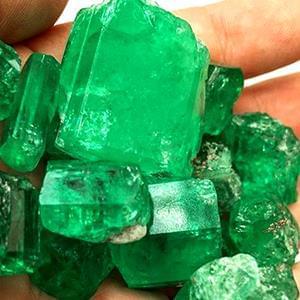
In Istanbul’s Topkapi Palace, there is an exhibition of these jewels, and all kinds of emeralds can be seen there
Vienna’s treasury includes a 12-centimeter-high, 2,205-carat vase made of an emerald
Queen Elizabeth II had a special room to store her jewels and it is said that this room is the size of a hockey field and is under the diameter of Buckingham
Of course, this does not include the British Crown Jewels, which are kept in the Tower of London
The queen’s personal jewelry has a value of 57 million dollars
The jewels in the Queen’s collection include the Cambridge and Delhi jewels, which feature an impressive emerald
Elizabeth Taylor had a famous jewelry collection
Richard Borton gave her an emerald and diamond brooch, which she wore with a diamond necklace on her wedding day
Earrings, bracelets and rings were also given as gifts later
Maintenance and cleaning of jewels and emerald gemstones
Expensive emeralds are sensitive to pressure and vulnerable to household chemicals. Even though emerald is one of the hardest gemstones, care must be taken when handling it. You must be very careful when preparing emeralds because the ratio They are more fragile than other forms of beryl. Avoid wearing emerald jewelry when working with chemicals or household detergents. Clean them with a little soapy water and a soft cloth. All soap residue must be removed. Do not use steam cleaners and ultrasonic cleaners in these jewelry because it destroys the oil used in emeralds. Old oiling is a good method for emeralds, but it is not permanent, so it must be repeated regularly. Remove before exercising, cleaning, or engaging in physical activity. Diamonds can scratch emeralds, so keep them away from other jewelry in a soft tissue

